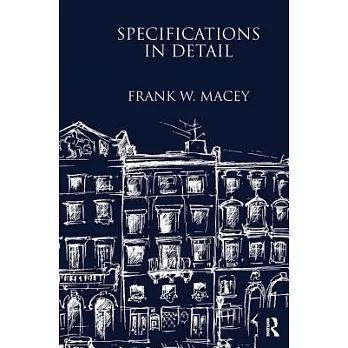Sir Roger Pratt's "Rules for the Guidance of Architects", written on 7 December 1665, included the following statements which embody succinctly the principles of the specification of building works and indeed of contract administration, and are as true today as they were nearly 350 years ago: To determine anything without due premeditation is rashness. Not to come to any determination in a convenient time is an effect either of ignorance or sloth. To wittingly omit to do that at the first, which at last we shall be forced to, at our greater disadvantage, is the extremity of folly. To be so forward in premeditation as to make no trade at a stand for want of direction, which will cause great repining etc. and to be careful to see them exactly performed, for otherwise all trades will be at catch with him. To contrive all things with the most orderly thrift and longest duration. However, Pratt seems to have relied on entrusting the works to known competent workmen rather than incorporating these wise principles in a written specification. This method of working appears to have continued until the rise of the general contractor in the nineteenth century when a written specification became an essential part of the design process. The specification was needed to describe the materials to be used and ways of working them and to ensure comparability of tenders, particularly for public works. This encouraged books on specifications, starting with Alfred Bartholomew's "Specifications for Practical Architecture" in 1840, revised in 1846. It began with a long 'essay on the decline of excellence in the structure and in the science of modern English buildings with the proposal of remedies for those defects'. This was followed by 54 specifications for various types and classes of buildings, notes on various materials, and an alphabetical digest of the London Building Act, with a comprehensive index - a multi-purpose book, like many of its successors. Noting that Bartholomew was no longer in print, T. L. Donaldson was prompted to produce his Handbook of Specifications in 1859, in which, after setting out the principles of specification writing, he reproduced 46 specifications for actual buildings and other works by his illustrious contemporaries. This included the "Houses of Parliament" by Sir Charles Barry and "Newcastle High Level Bridge" by Robert Stephenson, and was followed by 136 pages on the law as applied to building matters. This is a fascinating book, invaluable to construction historians, but will have been of less use to authors of specifications than a sequential list of trade-based clauses. Bartholomew's book was revised again, twice, by Frederick Rogers, in 1886 and 1893, but still with a similar 'essay' followed by specifications for various types of building (but now only 27), rather than trade-based clauses, for which we had to wait for the first edition of Macey in 1898. Frank W. Macey's predecessors had a tendency to set out what should be covered in specifications and the ills of poor specification, together with a quantity of information about the use of various materials and construction methods. This was admittedly useful, but better covered in the books on building construction that had started to appear at about the same date, such as Mitchell and Rivingtons (published in facsimile by Donhead in 2004). Macey, by contrast, dived almost straight in to trade-based clauses in a logical order. The specification author in an architect's office must have heaved a sigh of relief when Macey landed on his desk, because here was a book that provided just what he needed to 'cut and paste', in the order he needed it, and with marginal sketches showing how the materials and details were applied. Similarly, students of architecture had a useful source of reference for the work by the various trades, instead of having to look at the trade in each specification when referring to earlier books to decide which example to follow. Contemporary reviews of Macey criticized the book for being 'out of date' as he failed to cover all the latest developments in materials. In hindsight that attitude appears less than fair, because any architect incorporating recently introduced materials, such as reinforced concrete or metal lathing, would make sure he was fully conversant with them and their use, and would be able to describe them adequately as a matter of common prudence. No book would be able to keep up to date with the rapidly developing variety of materials appearing almost daily at the dawn of the Edwardian era. That was more than adequately addressed by the annual (initially quarterly) Specification published by the Architectural Press, which started the same year that the first edition of Macey was published and continued to keep construction professionals informed every year until 1992. Frank Macey revised and enlarged the text in 1904 for the second edition, having published his companion volume on "Conditions of Contract" in 1902, and taking account of criticisms in The Builder's review of his first edition. It is his second edition that this introduction accompanies, having been chosen by Donhead to give us an exhaustive reference to the materials and construction in use at the end of the Victorian era and the dawn of the twentieth century. It will also help us today when drafting specifications for work on buildings that have just passed their centenary. Frank William Macey (1863-1935) practised as an architect in the City of London before emigrating to Canada. He was the first resident architect in Burnaby in British Columbia, where he settled in the first decade of the twentieth century, and obtained a number of commissions from prominent businessmen who were building grand homes in the new community of Deer Lake. He designed predominantly in the British Arts and Crafts style and introduced the use of rough-cast stucco for building exteriors, a characteristic for which he was renowned. He



 天天爆殺
天天爆殺  今日66折
今日66折 
























 博客來
博客來 博客來
博客來 博客來
博客來 博客來
博客來 博客來
博客來